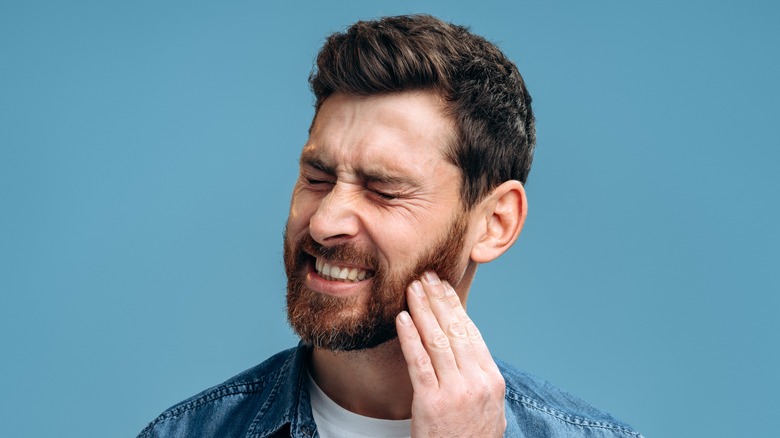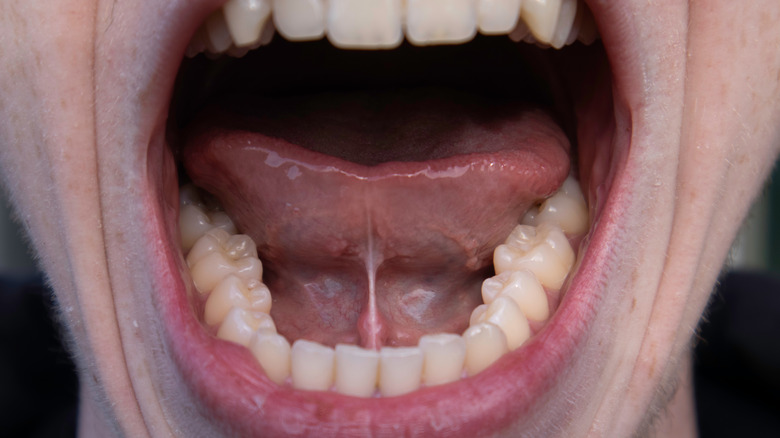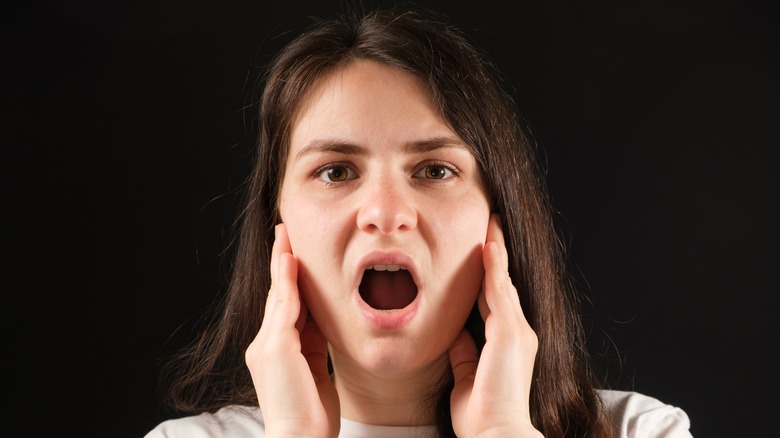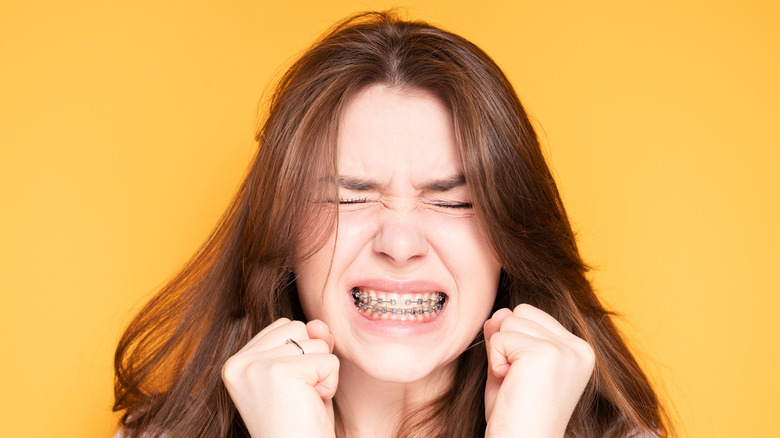Life can be pretty awesome, but there’s no denying that it can be pretty stressful, too. Stress manifests in the body in many different ways, but few are as persistently apparent as painful muscle tension — a condition in which a muscle stays contracted for an extended period of time (per Spine-Health). According to the American Psychological Association, muscle tension can be thought of as the body’s reflex to stressful situations — a way of bracing itself against expected pain. While some people carry most of their tension in their neck, shoulders, or lower back, others feel the brunt of it in the jaw.
Bruxism is a condition characterized by the unconscious grinding or clenching of the teeth (per Mayo Clinic). While people who engage in teeth clenching during their waking hours suffer from awake bruxism, those who do it during sleep are considered to have sleeping bruxism. The Academy of General Dentistry reveals that one in three people live with bruxism. While some people may be able to change their behavior through vigilant directed attention, others may require therapy to relearn how to relax those muscles.
The symptoms and causes of bruxism

Regardless of what kind of bruxism you have, the side effects are equally as dire. They include abraded, chipped, or flattened teeth, the wearing away of tooth enamel, leading to exposed dentin, and increased tooth pain and sensitivity. Other symptoms might include face, jaw, or neck soreness, tongue indentations, ear and headaches, tired, tight, or locked jaw muscles, and disturbed sleep (per Mayo Clinic).
Johns Hopkins Medicine notes that excessive stress is one of the most common causes of bruxism, but it can also be linked to certain personality types. People who experience nervous tension related to anger, pain, and frustration, as well as those with a more hot-tempered, competitive, or urgent nature are most likely to have problems with bruxism. Medications, including certain antidepressants, have also been known to bring about teeth clenching.
Bruxism can be painful, but this list of exercises may help relax the jaw and offer you some much-needed relief.
Awareness exercise

Bruxism is one of those sneaky conditions that happens on an unconscious level, but oftentimes, bringing some awareness back into the body can make a world of difference. When we clench our jaws, our tongue naturally rests in the hollow behind our bottom teeth. However, Colgate points out that when we place the tip of the tongue directly behind the two front teeth, it becomes impossible for our jaw muscles to contract.
By making a concerted effort to correct ourselves whenever we feel our tongue fall away from the roof of the mouth, we can train those jaw muscles to stay in the correct position. This exercise also makes it easier to identify your triggers or the times you are most likely to start clenching. Once you know what your triggers are, you can become more proactive, implementing this technique when you feel that tension in your jaw start to arise.
Masseter massage

BlurryMe/Shutterstock
The masseter muscles, located between the cheekbone and the ear, are the main muscles we use for chewing (per PainScience). These are also the muscles responsible for teeth clenching and grinding. Our masseter muscles are a prime location for trigger points — commonly referred to as “knots” — which occur when muscle fibers become locked in a contracted state (per Cleveland Clinic). A knot in the masseter muscles can cause bruxism, as well as tension headaches, tinnitus, and Temporomandibular Joint Syndrome (TMJ), according to PainScience, but a massage can help.
To massage the masseter muscles, place your thumbs just below the cheekbone — about an inch from the ears — and apply pressure inwards and upwards. You can either press with continued, firm pressure, or massage in small, circular motions. The masseter muscles are rather durable, so if it feels good to you, don’t be afraid to use your second knuckles or an osteo-pressure tool to get in there a little deeper.
Jaw exercises

Garna Zarina/Shutterstock
While there is limited research examining the benefits of jaw exercises in relation to bruxism, anecdotal evidence suggests that they might help (per MedicalNewsToday). When performed in a slow and intentional manner, these exercises may help loosen tight jaw muscles and ease uncomfortable symptoms.
To practice a relaxed jaw stretch, simply place the tongue on the roof of the mouth and let the bottom teeth fall away from the top teeth. Once you’ve held that position for a few moments, you might make the smooth transition into the goldfish stretch. To do this, keep the tip of the tongue behind the front teeth and place your index finger on your chin, with your thumb on the temporomandibular joint — or the place where your lower jaw meets the skull. Slowly lower your jaw as far as you can before closing your mouth again, and then repeat. Next, you might add a bit of resistance by placing your thumb under your chin and applying a bit of upward pressure while you slowly and intentionally open your mouth, pressing into your thumb.
Get the neck and shoulders involved

Ground Picture/Shutterstock
Bruxism can be a real pain in the neck — literally. Because your neck muscles are connected to your jaw muscles, the tension that begins in the jaw can quickly spread to the neck, creating stiffness and pain (per Delta Dental). While working on the neck won’t kick bruxism to the curb, it can ease some of the discomfort associated with it and start undoing some of the tension in that area, according to Mocrae Dentistry. Experts recommend counting to 10 as you slowly bring your chin to your chest. When you reach 10, your chin should be pressed firmly into your chest, where you will hold it for another 10 seconds. After that, slowly lift the chin back into the starting position on another 10 count. Repeat this until the neck feels loose, and don’t forget to keep the face and jaw relaxed throughout the entirety of this movement.
Once your neck is good and loose, move down to the shoulders. Mocrae Dentistry suggests lifting the shoulders toward the ears and rolling them back a few times until the shoulders feel relaxed. When there’s less tension in the shoulders, we aren’t as likely to clench the jaw.




